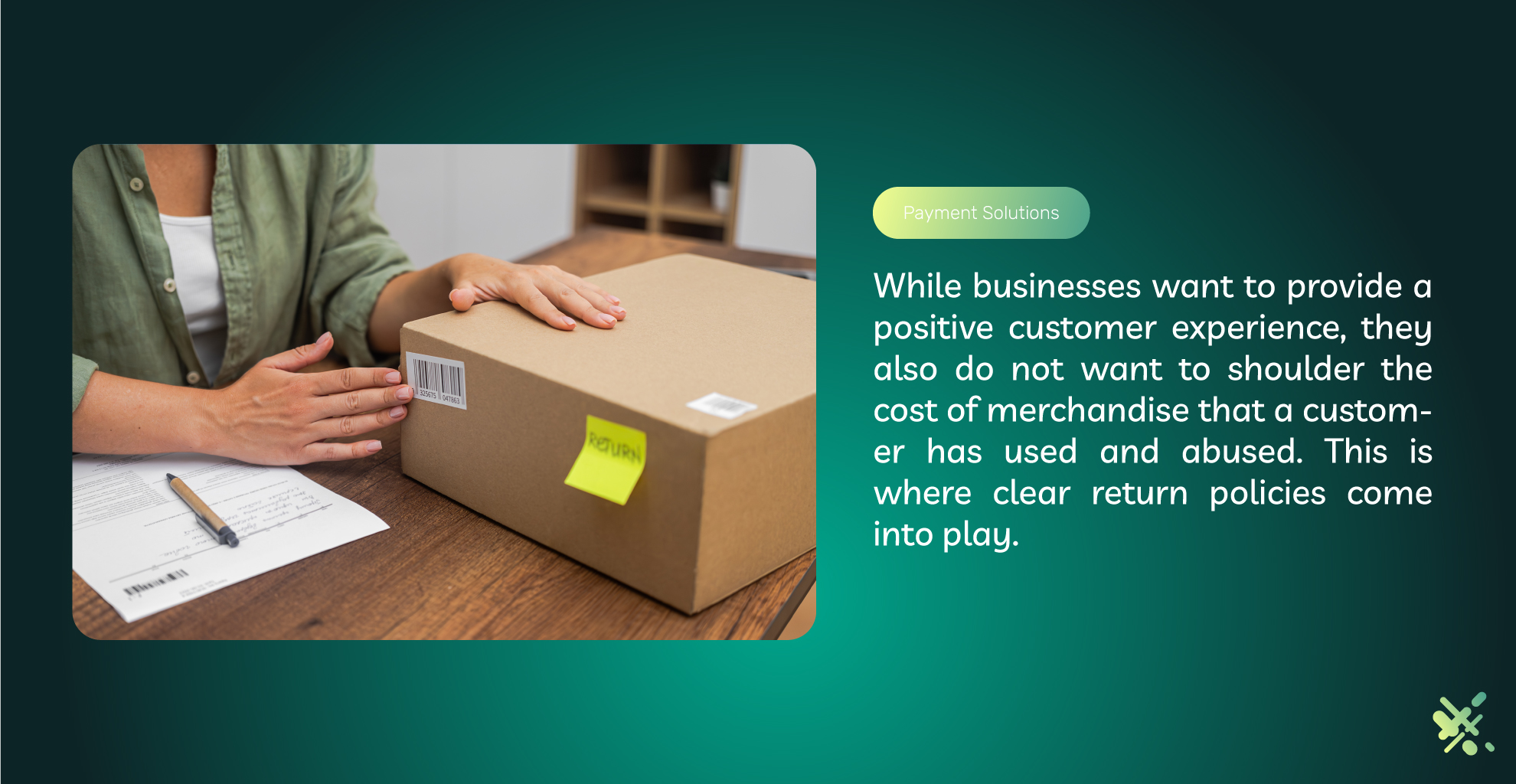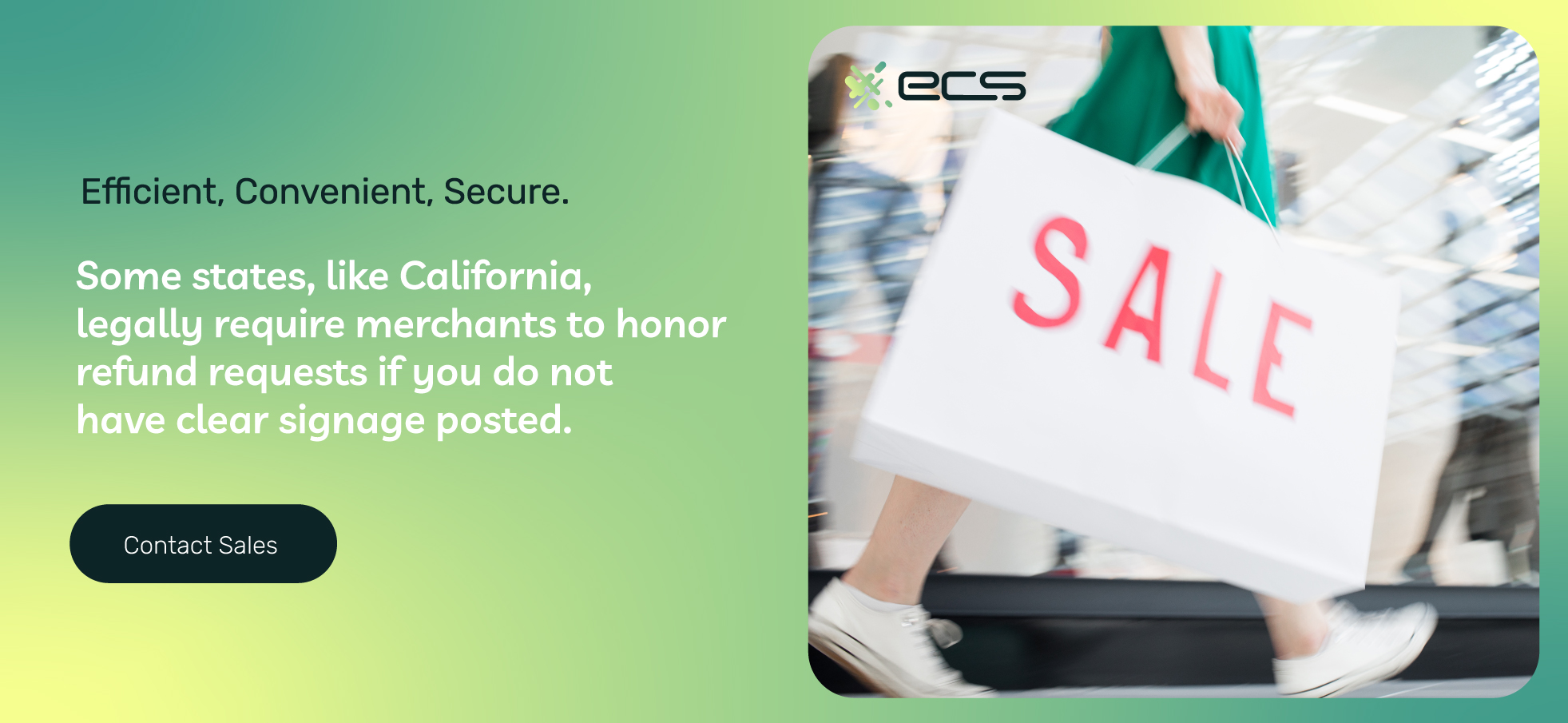“Free returns” has become one of the most frequently used phrases in retail, along with “satisfaction guaranteed, or your money back.” But then other phrases populate the consumer consciousness, like “you break it, you buy it.” While businesses want to provide a positive customer experience, they also do not want to shoulder the cost of merchandise that a customer has used and abused. This is where clear return policies come into play.
Why Do Customers Return Items?
According to one study, 80% of online shoppers who made a return did so because of damages from shipping (or even before). 64% said the item did not match the description, while 37% just didn’t like it. 7% were upset with delayed delivery, and 7.5% thought the item’s quality was poor.
How common are returns? A survey of internet users gauged how many shoppers returned an online purchase within the past year. 73% of consumers in India said they had made a return, 66% in China, and 49% in the United States.
These findings might speak to the nature and quality of infrastructure in each place (in terms of successfully delivering the product to the customer). But it is still noteworthy that nearly 50% of American consumers still return at least one thing after 12 months.

Is It Harder To Return Online Purchases?
You might think there is a marked difference between the amount of returns of online purchases versus in-store purchases. After all, online purchases create more opportunities for surprises…like a dress not fitting or a carpet not being the color you thought it was. Retailers like Amazon use AR (augmented reality) to reduce the number of returns by allowing customers to actually “try on” items or position them in their homes with the smartphone camera.
But ultimately, both in-store and online return rates are neck-in-neck at 16.5% and 16.4%, respectively. Those numbers were brought to you by Capital One, the bank that unleashes Viking hordes who demand to know what’s in your wallet. Capital also found that in 2022, consumers returned $212 billion from online sales and $603 billion (nearly three times that) from in-store sales.
Those numbers are actually quite fascinating. In other words, although online and brick-and-mortar returns happen at the same rate, the dollar value of in-store returns is greater. While conjectures are beyond the scope of this article, one can hypothesize. It seems daunting to repackage an item, drive it to the post office (or UPS storefront), wait in line, and ship the item…even if the vendor offers free return shipping.
Walking into a store and handing over the item for an immediate refund, exchange, or store credit seems much easier. Perhaps Capital One could send out the Viking hoard for market research. As a caveat, keep in mind that other studies have concluded that there is actually a huge discrepancy between online and in-store returns, at 30% and 8%, respectively.
Some customers will return an item ordered online to a physical store. 58% of consumers do this because they don’t want to pay for shipping (presumably, in these instances, the company does not pay for return shipping).
53% say it’s just faster. 41% cite the convenience of the store. 38% want an immediate refund. 34% want an exchange, 30% go this route because they visit the store regularly anyway, and 25% want a store credit.
Amazon is an example of one company that has successfully leveraged these findings to improve customer experience vis-a-vis returns. As of 2023, dissatisfied Amazon shoppers can return an item at their nearest Amazon Store…or UPS, Whole Foods, Kohl’s, and Staples.
They do not even have to repackage the item. The store associate will take care of that for them. All they need to do is drop it off, and within a day or so they receive a refund.
Of course, not every retailer can afford to be as generous as Amazon, absorbing loads of refunds and potentially damaged or defective items. This is why the typical small business retailer needs a transparent return and damage policy. You will want the return policy.
What is a Return Policy?
A return policy is your business policy about accepting returns. In the main, your return policy will need to spell out four things: policy duration, breadth of coverage, liability, and process. Contrary to what you might think, customers read the fine print of a return policy. A 2022 study by Shippo found that 84% of customers shopping online read return policies before buying and that 44% would actually look for a different website to shop on if they didn’t like it.
Policy Duration
Policy duration will determine how long customers must return an item. There is no right answer to how long this timeframe should be. Some policies are 15-30 days. Others are 90 days. Some stores (surprisingly) have year-long return policies.
Overall, there are two concerns you are juggling with the policy duration. One is that you want to give the customer adequate time to see if the item works for them. Another is that you want to avoid the item becoming irreplaceably damaged. The “intersection” of these two lines on the proverbial graph is your sweet spot for policy duration.
Obviously, customers cannot return some items. Swimwear and undergarments could (in theory) be returned. But in addition to the fact that no customer would purchase these items (although…never say never), it’s also an unhygienic liability.
Breadth of Coverage
The breadth of coverage will spell out acceptable reasons for returning. A more comprehensive policy would allow the customer to return the item for any reason (e.g., customer satisfaction). More restrictive policies would only allow the customer to return an item if it was damaged before they purchased it, or inherently defective.
This aspect of the policy may also spell out what the customer can expect with their return. Will they be issued a refund? An exchange? A store credit? A partial refund or store credit?
Note that technically speaking, return policies and refund policies are two separate entities. However, you can present them to your customers as a single unit for simplicity’s sake.
Liabilities and Limitations
Liabilities and limitations can spell out some limitations on the return policy. One example is water damage. Many retailers will not allow for the return of electronic devices if there is water damage. Common sense would suggest electronic devices will no longer function after undergoing water damage. However, a return policy should still spell this out.
Think of the sold item as undergoing a trial period. During this trial period, the consumer (purchaser) assumes some liability for the reasonable care of the product. It is unreasonable for the customer to expect the merchant to take the item back if they used it outside its normal functioning or pushed beyond its limits.
The particulars of product liability will vary from industry to industry, but overall, the theme is the same. Customers should use products for their intended function. Requesting a refund after using the product beyond its intended purpose and causing damage is an unreasonable expectation. It’s akin to a diner who consumes half of their burger and then sends it back to the kitchen, asserting it wasn’t cooked to their liking.

Process
The process will spell out the process for returns. Does the customer need to initiate a return by calling or emailing? As a side note (one we’ll elaborate on later), this can be a great way to cut down on returns; a customer service agent can assist in troubleshooting the issue or resolving the problem.
How will the customer return the item? Do they need to package it a certain way? Do they need to ship it through a certain vendor? Will they pay for shipping or use a prepaid shipping label? Can they bring it into a storefront, like Amazon handles their returns? Will they have their choice of an exchange, credit, or refund? How will the refund be issued?
Spelling all these steps out is necessary for guiding the customer through the refund process. But incidentally, it can also assist in decreasing your returns and refunds. Remember that customers do look for return policies.
If they see a policy spelled out clearly, they may feel the company can competently address their issue without seeking a refund. Remember that today’s customers value transparency. In fact, more than 90% of polled consumers state that transparency is a key motivator in purchasing decisions.
Refund
With a refund, the customer returns the item and receives their money back. A refund may be full or partial. There may be fees that you tack on to the refund, such as a shipping fee or a restocking fee. Alternatively, you may ask the customer to pay for shipping.
However, customer experience will be the most salvaged if you charge no fees and cover the shipping. Of course, that type of policy should be subject to a cost-benefit analysis. This policy may not eat into the profit margin for a behemoth-sized business like Walmart or Amazon. For a smaller business, focusing on customer preference could become financially onerous.
Customers want to receive their money back quickly. If they don’t get it back, they may pursue a dispute with your bank, which you want to avoid. One way to avoid the revenue loss of a refund is to gear your customers toward an exchange.
Exchange
That’s where an exchange policy comes into play. An exchange may not be the option that every customer is looking for. Indeed, some customers will want an exchange, such as customers who pick out the wrong apparel size. But other customers may not. They might just want a quick and easy refund before they move on with their life.
This is where good customer service comes into play. Larger businesses have entire departments devoted to “customer success” or “customer retention.” Some departments have the specific allocation to turn negative customer experiences into new opportunities.
Who says your small business can’t adopt the same mindset? This is especially true if your policy only offers exchanges and not refunds. If your state mandates refunds for inherently defective items, consider directing products eligible for discretionary returns toward exchanges as a preferred option.
Two types of exchanges are the variant exchange and the product exchange. The variant exchange is when a customer swaps out a more fitting variation of the same product—like a different set of plates or a different-sized article of clothing. The product exchange is when the customer trades in their purchase for an entirely different product.

Store Credit
The store credit is another alternative to the simple refund. A store credit is a form of in-store currency the customer can use to purchase a different item. Alternatively, you can also issue gift cards. The upshot of the gift card or store credit is that you will keep your revenue and perhaps incentivize a return visit at a later date.
If you offer multiple pathways to return (refund, exchange, store credit), you can incentivize the store credit by offering a 10% discount on the next purchase or something similar. Store credits also provide a positive customer experience because they offer customers the increased flexibility of coming back another day.
Store credit is a popular option in certain situations, such as a return of perishable food. With returns of food, the original packaging may be open, and the customer may no longer have proof of purchase (e.g. a receipt). However, they either claim they obtained the product from you or the packaging indicates that this is clearly the case. In these cases, you could offer a store credit instead of offering refunds.
Warranty Return
A warranty covers some products. Often, the product manufacturer has their own warranty, and the customer must contact the company for any product issues. However, a customer may choose not to do this and return the item to you instead.
A federal law of implied warranty or merchantability is part of the Uniform Commercial Code. The code states that when you sell an item, it must be merchantable. In other words, it must be:
- Of “fair average” quality.
- Fit for its usual purpose.
- Conform to promises made on the packaging.
However, let’s say your return policy specifies that the customer only has 14 days to return. In these cases, the customer will have to appeal to the manufacturer if there is a problem with the product beyond that timeframe.
Many retailers like to shy away from offering warranties on their products. Instead, they rely on the manufacturer’s warranty. In some cases, they may sell third-party warranties. These additional insurance options are often called an Accidental Damages and Handling Plan (ADH). Typically, merchants can sell these at the point of sale.
Although the retailer sells the warranty, a third party, such as an insurance company, manages it. The retailer is still responsible for presenting the claims process disclosure and other information about the warranty. Many retailers refer to these as “protection plans.”
Do Free Returns in my Return Policy Increase Sales?
Around 96% of customers will make another purchase from a company that provides an easy return policy. According to some studies, roughly 60% of shoppers make buying decisions based on the return policy. Lastly, 96% of shoppers will indeed be more likely to purchase if merchants offer free returns.
“Love it or your money back” has become (as we said in the intro) staple parlance in retail. The phrasing may have originated with 18th-century potter Josiah Wedgewood before Sears Roebuck Company appropriated it. The psychology of the strategy is simple: it builds trust.
Of course, blanket promises are best covered with some small print. While you can promise satisfaction guaranteed, you should outline the details mentioned above, so customers do not abuse your generosity, or use it as a lever to commit fraud. State the duration of the policy, the breadth of coverage, liabilities, and limitations, and explain the process.
Adding clarifications to your customer happiness guarantee can enhance brand sentiment positively. As mentioned, 9 out of 10 shoppers pull the proverbial trigger on a purchase partly because they know they can return it if it doesn’t work out.

Can A Store Refuse To Give a Refund?
Yes, you can post an all-sales-are-final policy. There are certain instances, however, where this signage will not cover you. For instance, in many states, “lemon laws” protect consumers from unscrupulous automobile salespeople.
Normally, a customer cannot return a newly purchased vehicle for a full refund once they’ve driven it off the lot. However, if the vehicle is defective, they can (to provide a gross oversimplification of these laws).
Whether or not you want to impose an ASAF policy (all sales are final) will depend on a few factors. As mentioned earlier, certain types of merchandise cannot be returned. In addition to things like undergarments or socks, there are also personalized items. These items cannot be resold, and it is reasonable to post such a policy.
You may also want to post such a policy for clearance items. You are trying to get rid of this inventory, and you don’t want it to come back. Usually, the markdown on these items is low enough that it’s not worth it for customers to bring it back or invest effort in learning to get around a no-refund policy.
However, in all instances, you should still post clear signage. Some states, like California, legally require merchants to honor refund requests if you do not have clear signage posted. The California return policy is just one example of consumer rights for refunds. Your local chamber of commerce is a good resource for ensuring your policy’s compliance with state regulations, including final sales.
How To Reduce Refunds
Now, on to one of the most important questions in this purview of refund policies: how to avoid refunds entirely! Product returns are going to be inevitable. The first thing you can do is hedge the refund process with some rules. For instance, you could state that you will not accept returns without a receipt or that customers must exercise their rights for a refund within 14 business days.
Whatever your terms and conditions are, you should post them clearly in your store or on the website where patrons shop online. For instance, the footer of your website is a good place to post your return policy for products or services. You should provide a phone number, email address, and/or other contact information for customers who want more information.
As mentioned, clear signage about your return policies may actually improve your bottom line by increasing sales. And some states (like California) require it. So the two main things you can do to reduce refunds are (1) post clear signage explaining your refund policy and (2) create a refund policy that strikes a nice balance between customer satisfaction and protecting your revenue.

Refunds For Service-Based Businesses
What about a refund for a service-based business? This can be difficult to navigate because there are no goods you can re-absorb into your inventory. In fact, you have already lost the time you allocated for rendering this service, and it cannot be recovered.
Once again, it is important to post your refund policy upfront. If you make specific promises as part of selling your services, these may be cited when a customer attempts to collect a refund. This is why it’s important to cover all limitations in writing.
Let’s say, for example, that you are a personal trainer who promises to help clients get to their ideal weight in six months or their money back. It will be very important for you to present your clients with a contract specifying anything they need to do to affect that goal and voiding the customer’s rights for a refund if they don’t.
For instance, in this case, you may specify that if a client does not stick to their diet plan and meets you in the gym three times weekly, they will forfeit their right to a refund, despite your claims of meeting their ideal weight or their money back.
Service-based businesses should include refund terms in the client contract, clearly outlining the services they will provide.
The Importance of Preventing Chargebacks
Last, we should mention that disclosing a refund policy is crucial for reducing chargeback risks. This is because the refund policy will spell out how a customer can get a refund, exchange, or store credit.
Without these options, they may initiate a dispute with your bank. This is bad news for your business. A dispute initiated with their bank or credit card company is a chargeback. The chargeback involves the customer’s bank contacting your bank to pull the funds back to where they came from.
The reverse motion of these funds through the payment landscape of card networks, clearinghouses, and payment processors creates an avalanche of fees that you mostly shoulder…the business owner.
Chargebacks can cost a business up to $200 on average in fees and lost merchandise. Unfortunately, chargebacks are fairly common and are becoming increasingly more common. One reason is that the customer may feel it’s just easier to call the bank than to call you for a refund.
This is why it’s so important to clearly disclose your refund policy to customers as plainly as possible. You want to give them an adequate pathway for requesting a refund or contacting you about problems with the product. Without this roadmap, they may initiate the chargeback dispute process.
Return Policy Wrap-Up
It’s important to post your return policies clearly, whether online or in your store. In some states, you will be forced to honor customer requests for refunds, against your policies, if you do not post signage (e.g. instead of offering exchanges or store credits).
Posting your policies also creates a positive customer experience and may help increase sales. One place to display return policies is the point of sale, whether an online shopping cart or a physical POS terminal. Contact us to learn more, or fill out the form below.
Frequently Asked Questions About Disclosing Your Return Policy to Customers
Customers choose to return items for many reasons, no longer needing the item, poor quality, shipping damages, description mismatches, personal preferences, delayed delivery, and poor quality.
To reduce refunds and keep your profits, your business can set specific return rules, such as requiring a receipt or limiting the refund window. Posting clear signage about your return policy can help prevent misunderstandings. We also recommend carefully choosing your shipping partners and being upfront about your products’ description, delivery times, and quality to reduce return rates. By offering a seamless payment experience, ECS Payments can also help contribute to a positive customer experience reducing returns.
In-store and online return rates are similar, with 16.5% for in-store and 16.4% for online. However, the value of in-store returns is greater.
Under certain circumstances, your store can impose an “all-sales-are-final” policy. However, this may not be applicable to all situations. Lemon laws protect consumers, and clear signage is required. Some personal items, like undergarments and custom-made items, are generally nonrefundable, but regulations vary by state.
Chargebacks can be costly for businesses. Disclosing a clear refund policy and being transparent about your products and shipping helps reduce chargeback risks by providing customers with a clear understanding of their purchase, refund requests, exchanges, or store credits, which can prevent them from initiating a chargeback with their bank.
